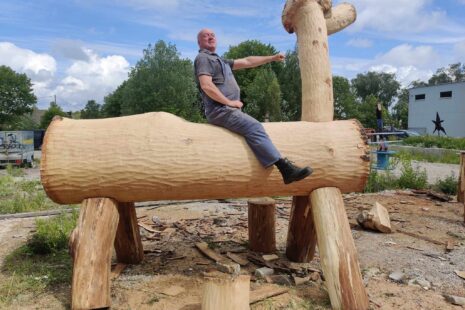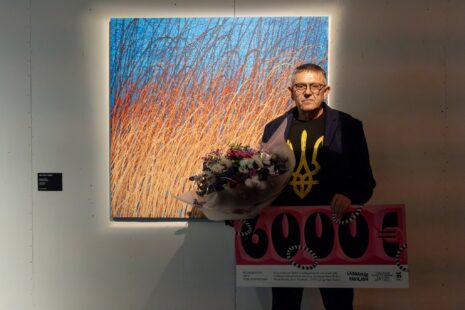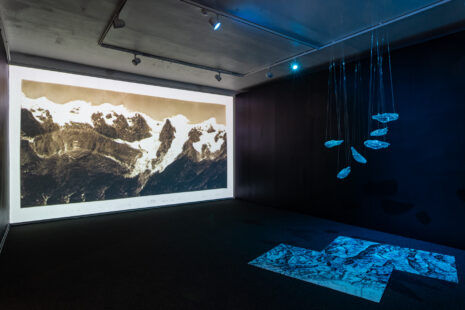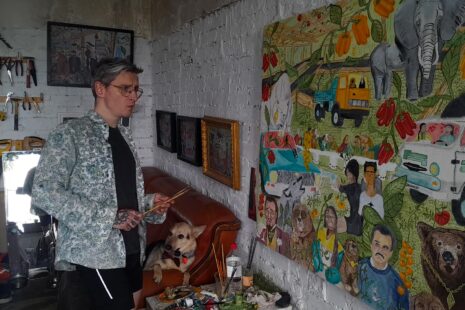You have studied in the painting department at the Art Academy of Latvia. Painting as a traditional medium in fine arts was considered rather unmodern meanwhile and winning back its position again now. What was the reason for you to choose that speciality?
Looking back at the time when I applied to the Bachelor’s program in painting six years ago, I made the choice rather intuitively. All I knew back then was that I wanted “to create new worlds” – you could also call them “spaces” -, and painting seemed like a good medium in which I would be able to that. But, If I have to answer the question now, I would say that, besides this ability to create new spaces, one of the greatest things that fascinates me about painting is its stillness. No matter how expressive the painting is, how dramatic or even emotional, it still remains quiet. It is somewhat like gazing upon a landscape after a hurricane – it is very still, yet you can still sense the hurricane that went through the landscape before – in this analogy the hurricane would be the artist.
I would like to emphasize that in this day and age, the previously mentioned “stillness” is a rather rare quality for an image to behold – every day we are bombarded with moving, blaring images, such as advertisements, GIFs and so on. In comparison to this visual pollution that we live in nowadays, painting to me has always seemed like a breath of fresh air. Painting leaves room for contemplation. Painting does not sell you anything.
Painting is not “useful”, and for me it is precisely the reason why it brings meaning to my life.
In 2019 you also participated in NBYAA contest. Back then you said: „Looking upon my studies so far, with each passing year I feel a more stronger urge to surpass the traditional „oil on canvas“ stereotype about painting. I truly believe that painting is a state of mind that and artist can have, not just physical medium“. How strong do you feel now, after two years have passed?
I think it has gotten worse – I even make sculptures now! (Laughs.) Truth be told, I am very proud of the advanced level of technical abilities that my Alma Mater – Art Academy of Latvia – provides to their students. During Bachelor’s program I was painting and drawing almost every day – painting portraits and nudes up to three hours in the morning, then lunch, and afterwards drawing nudes for two hours, and then again painting for the rest of the day. It was quite a schedule, but it left a powerful mark. I truly believe that having one medium as a starting point can be very beneficial to the striving artist – because then you have a strong set of tools with whom you can operate in order to manifest your idea.
But, coming back to your question, I also believe that a painter isn’t obliged to paint paintings for the rest of his life. Some ideas just don’t come in the form of a painting – at least to me. I enjoy creating installations, sculptures, photographs, but no matter what medium I try, there will always be a snippet of my paintings there. That is just how my eye is trained to look at things.

Both in 2019 and this year your work consists not only of paintings, indeed. Tell us about the techniques you used and how they support your inspiration of the series „Whole“ which „was born in the dark shadow cast on to us by the global pandemic.“
The series “Whole” started out of desperation. I was so sick of the virtual, the illusory, that came with the new order of life. I just wanted to get my hands dirty. At the time I was very interested in old healing rituals and latvian folklore, so the first works were basically created in the forest – I engaged in those rituals, that were documented and later transformed into artworks.
My biggest concern was – how to bring the experience that I had in the forest to the exhibition space back at the city. My goal was to be sincere, and since I am a born and raised city girl, I soon realized that I can’t just illustrate the experience by painting trees and landscapes. Somewhat by accident I came upon a block of leftover styrofoam that I dragged in my studio, and placed a bouquet of dried flowers – that I had collected in the forest – unto them. I fell in love with the contrast between the synthetic styrofoam and the natural flowers, and soon realized that this is the way to tell my story. I used styrofoam throughout the series, by creating objects that resembled natural forms, but actually were made out of this absolutely horrible material that doesn’t decay for thousands of years – by the way, I used only leftover or upcycled pieces of styrofoam throughout the series.
I think this clash of materials conveys the contradictory feeling of wanting to connect with nature, yet being unable to do it, since “wild nature” doesn’t exist anymore and everything has been invaded by man.
In the series “Whole” there are also some photographs, which have been printed unto a cotton fabric. I had these digital photographs of the rituals I engaged in the forest, and for a long time I wasn’t sure what to do with them. Once I stumbled upon this old cotton fabric in a photo studio – they wanted to throw it away as unusable, since it had turned from white to yellow. I printed the photographs unto the yellowing fabric, and later used them in creating the installation “Cycle”. I realized, that I had turned the digital photographs into mortal objects, since the pixel can’t decay, but the cotton fabric can. And since my series of works were very much about the never-ending life cycle of birth and death, it seemed like a perfect solution for displaying the photos I made in the forest.

One of these rituals, for example, was „burying yourself neck deep in soil.“ Where do these rituals come from? At least Estonia is a rather pagan country with a belief in nature therapy, which is Latvia’s background in this sense?
All the Baltic countries – Latvia, Estonia and Lithuania – share some similarities in our national folklore, this also includes healing traditions. Latvian folklore and the old latvian world-view in general is based in animism – a belief that objects, places, and creatures all possess a distinct spiritual essence. In latvian the world “whole” has two meanings – one being “wholeness” and the other being “health”. From this we can easily deduct that for our ancestors the notion of “being healthy” was “being whole”, in other words – undivided, balanced, with a healthy mind and a healthy body.
This is precisely the reason why latvian healing traditions also come in two large sections: one being the practical section about which herbs are best for different diseases, and the second being the ritual part, because taking medicine wasn’t enough – the patient also had to practice his intention of getting well. I find this a very important lesson, when some of us nowadays are so used to popping pills just to eliminate the symptoms, but not looking at the cause of them, which may be stress, anxiety, burn-out and so on.

The exhibition „Whole“ was part of Art Festival Cesis, Latvia in summer this year. How would you compare the experience of showing your art in the physical exhibition space versus doing the same online which was the case of NBYAA contest? What to keep in mind?
Each of the experiences pose different challenges. When setting up an exhibition in a physical space, I always tend to think of the walking trajectory of the potential viewer, his or her “journey” through the exhibition. It is very important to observe how the artworks interact with each other. Some works can basically “kill” each other, while others complement each other harmoniously.
It’s like an endless Rubic’s Cube with no fixed solution, at one point you just have to come to a decision.
But when it comes to exhibiting digitally, I would say that the greatest challenge is the artists’ digital skillset. It is vital to know your way around a camera, Adobe Photoshop, Adobe Illustrator, to create decent photographs and a decent portfolio/exhibition catalogue. For example, sometimes a good artwork can look insignificant if it is photographed poorly, and vice versa.
And last but not least – Who are your own favorites from other participants of NBYAA’21 contest?
Although I could name a lot, to name a few I would say Katrin Enni (“Copper Fever”), Kamilė Jadevičiūtė (“Sediments of Time”), King Wai Cheung (“Whiteness, Emptiness, Cleanliness”) – I would absolutely love to see these works in real life! And from my latvian colleagues I would like to highlight Kristīne Daukšte (“Actual pulp after pit comb culture”) and Reinis Bērziņš (“Reverse engineering a speaker cab”), as I have been already following their works during previous years.










